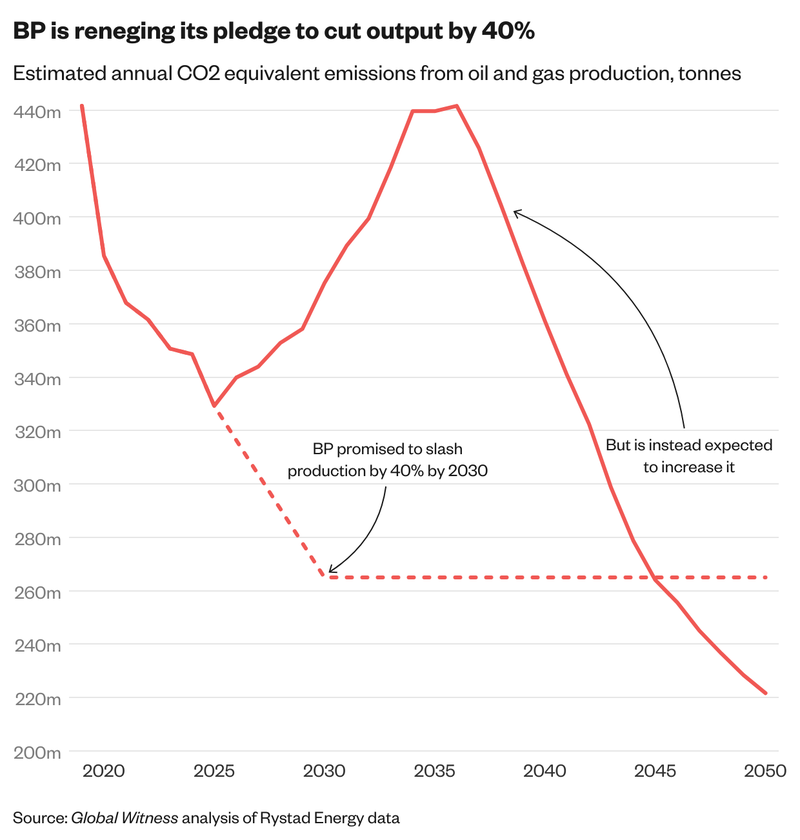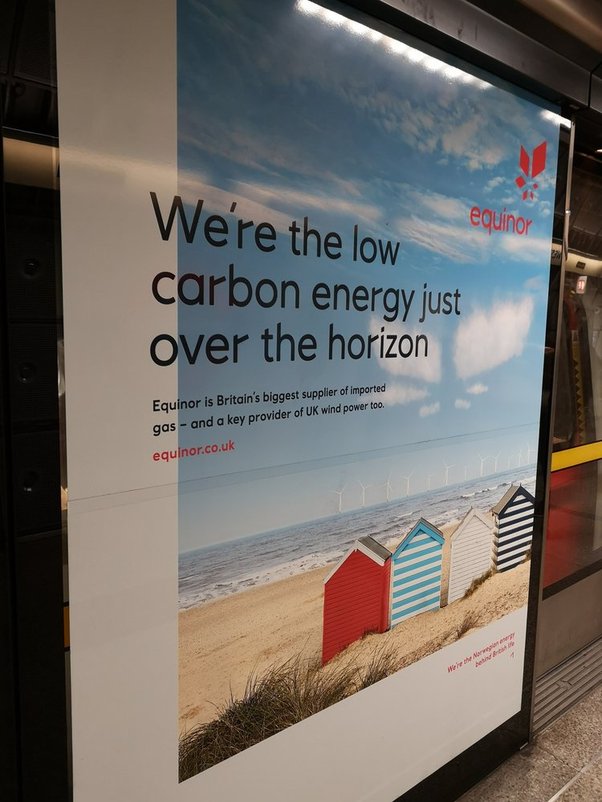Fossil fuel giant BP’s recent scrapping of its 2030 interim target to reduce production is estimated to cause 72,000 additional heat deaths by the end of this century driven by increased emissions from burning more oil and gas, new Global Witness analysis shows. The target was to cut oil and gas production by 40% by the end of 2030 relative to 2019
The analysis, which uses the mortality cost of carbon methodology, also looked at the impact until 2050 of BP scrapping its 2030 target to reduce production. If the oil firm stuck to its original target for the next 25 years, approximately 409,000 additional heat deaths could be avoided by the end of the century.
The net zero target BP originally set in 2020 committed the firm to cutting oil and gas production by 40% by 2030. The fossil fuel firm reduced this to 25% in 2023. Now they have scrapped the climate goal altogether.
The analysis comes amid steady criticism from a portion of investors over BP's recent climate u-turn, ahead of their upcoming AGM this Thursday (17 April). A group of institutional investors representing a reported £5 trillion in assets demanded a vote on the firm’s climate strategy at the company’s upcoming AGM, but BP appears to have denied their request.
Another activist investor group, Follow This, have called for a vote on the BP Chair’s reappointment, over the firm’s scrapping of green targets.
BP’s change in strategy means that the company’s increased emissions until the end of 2030 are likely to add approximately 72,000 heat deaths by the end of the century. Between 2031 and 2050, the recent strategy reset will likely result in an additional 338,000 heat deaths. In total, their increase in production from now until the end of 2050 will likely contribute an estimated additional 409,000 heat deaths.
BP did not respond to requests for comment.
Sarah Biermann Becker, senior investigator at Global Witness, said:
“After a year of unprecedented climate disasters, people want to see firm action to keep our world liveable for generations to come, but oil giants like BP appear to be laughing in our faces.
“Their deplorable climate u-turn will have deadly consequences, with tens of thousands of people set to pay the price for the firm’s prioritisation of short-term gains over the health of our planet.
“We know that children, the elderly, pregnant people and outdoor workers are especially vulnerable to extreme heat – they will be the people whose lives are on the line due to BP’s reckless decision-making.
“If Big Oil firms like BP won’t safeguard our lives, it’s clear we need governments to act. They should be steering us squarely towards a fossil-free future and pushing polluters to account for the damage they’re doing.”
Hadrien Goux, head of the fossil fuel campaign at BLOOM, said:
“By deciding to come back on their climate pledge, BP is intentionally choosing to risk these lives in the name of short-term profits.
“It is more than time that such decisions are criminalised, given the historical knowledge of these carbon majors on the consequences of their fossil business.”

Notes and methodology
- The data on oil and gas production was sourced from energy business intelligence agency Rystad Energy’s UCube database. UCube is an integrated field-by-field database of the global upstream oil and gas market, covering the time span from 1900 to 2100. Rystad’s data is widely referenced by major oil and gas companies, the media and international bodies such as the IEA.
- In 2020, BP announced their net zero ambition, stating an interim target of reducing their oil and gas production by 40% by 2030. This aim was reduced to 25% in 2023 and scrapped completely in February 2025.
- The company still has an aim to reduce the carbon intensity of their energy products by 8-10% by 2030. But carbon intensity measures emissions per unit of activity, which means that it allows BP to increase overall production. The company previously already had an aim to reduce lifecycle carbon intensity by even more (15-20%).
- Global Witness analysed BP’s oil and gas production data from Rystad Energy for the period 2019-2050. We compared the forecast production from 2025 onwards to a now defunct scenario where BP gradually reduces production by 40% by 2030 relative to 2019 levels in line with the original interim net zero aim.
- Production data were obtained from Rystad Energy on 11 March 2025 and converted to CO2 emissions using the UK Government’s greenhouse gas conversion factors.
- We used the mortality cost of carbon in the baseline emissions scenario, developed by Daniel Bressler, which predicts 0.000226 deaths between 2020-2100 per metric tonne of CO2 emitted in 2020. That means that adding 1 million metric tons of carbon dioxide in 2020 will cause an additional 226 excess temperature-related deaths over the next 80 years. Baseline emissions scenarios typically examine what would happen in the absence of further intervention beyond the climate policies already in place. The model’s baseline emissions scenario is a high emissions scenario, which results in 4.1°C warming by 2100 compared to preindustrial temperatures.
- There is another model examining an optimal emissions scenario, similar to the world reaching net zero by 2050. This results in a mortality cost of carbon of 0.000107 deaths between 2020-2100, per metric tonne of carbon emitted in 2020. The world is not currently on track to reach net zero emissions by 2050. In this scenario the emissions from BP’s oil and gas production due to their change in strategy by the end of 2030 would contribute 34,000 heat deaths by the end of the century. Emissions from oil and gas produced after 2030 until the end of 2050, it would add another 160,000 heat deaths by 2100.
- The model used to calculate the mortality cost of carbon is published in a peer reviewed journal, Nature Communications. It is one of the measures used to calculate the “social cost of carbon”, which assesses the monetary cost of the damages to society of one additional metric tonne of CO2 emissions. The social cost of carbon is a widely used measure, including by the United States Environmental Protection Agency. The methodology has also been used by organisations such as Oxfam to calculate heat related excess deaths associated with the top 1% richest people’s emissions.
- We included assets that are already producing (all assets that are currently producing), under development (assets for which development has been approved by companies and government but production has not yet started) and discovery (assets where discoveries have been made, but are not yet in a phase of further development) as well as undiscovered. The latter covers assets with estimated quantities of oil and gas that are probably present but have not yet been proven by drilling.


